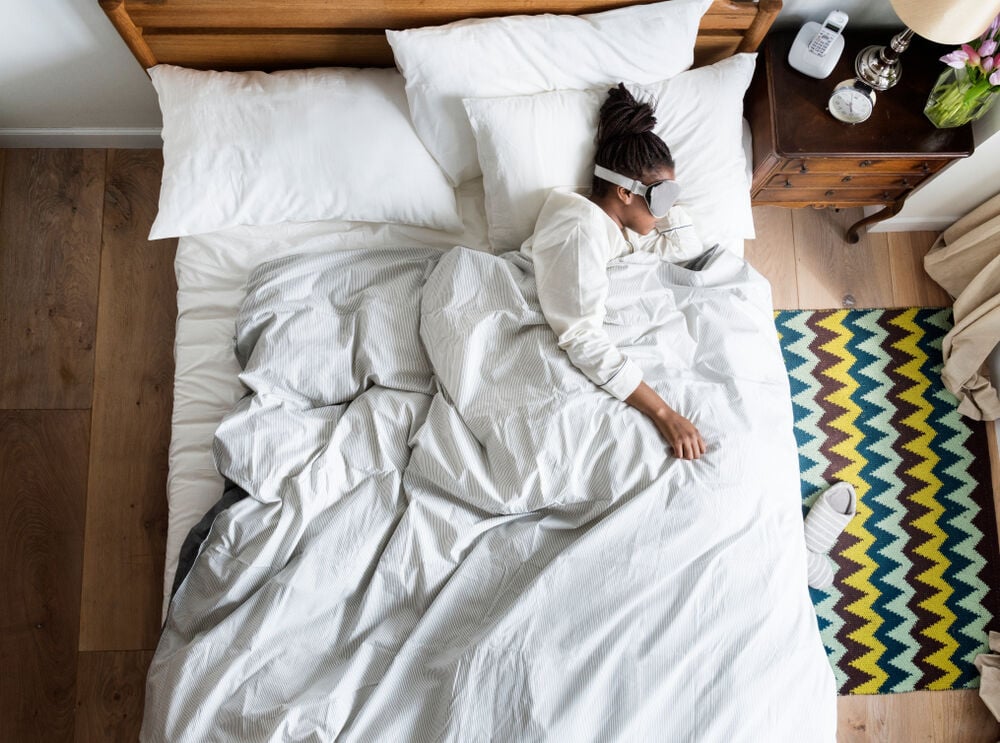Female orgasm during sleep is rare, but real nevertheless. Sleep orgasm, also known as “nocturnal orgasm,” is a combination of elevated blood flow to the pelvic area and being relaxed, which increases psychogenic arousal.
-
Tracking cycle
-
Getting pregnant
-
Pregnancy
-
Help Center
-
Flo for Partners
-
Anonymous Mode
-
Flo app reviews
-
Flo Premium New
-
Secret Chats New
-
Symptom Checker New
-
Your cycle
-
Health 360°
-
Getting pregnant
-
Pregnancy
-
Being a mom
-
LGBTQ+
-
Quizzes
-
Ovulation calculator
-
hCG calculator
-
Pregnancy test calculator
-
Menstrual cycle calculator
-
Period calculator
-
Implantation calculator
-
Pregnancy weeks to months calculator
-
Pregnancy due date calculator
-
IVF and FET due date calculator
-
Due date calculator by ultrasound
-
Medical Affairs
-
Science & Research
-
Pass It On Project New
-
Privacy Portal
-
Press Center
-
Flo Accuracy
-
Careers
-
Contact Us
Can you orgasm in your sleep? A complete guide to wet dreams


Every piece of content at Flo Health adheres to the highest editorial standards for language, style, and medical accuracy. To learn what we do to deliver the best health and lifestyle insights to you, check out our content review principles.
Is it possible to orgasm in your sleep?
Yes, orgasm during sleep is possible regardless of sex, and it is perfectly normal. It’s commonly called a nocturnal orgasm or wet dream. Nocturnal orgasms are mostly associated with male puberty, and they occur as a result of increased testosterone levels. However, wet dreams, or sleep orgasms, can happen to anyone.
According to research, sleep orgasms begin with a sexual dream. This leads to increased blood flow to the genitals in combination with the complete relaxation of deep slumber, allowing the body to orgasm without external stimulation. Sleep orgasms vary greatly from person to person. Some people don’t experience them at all, and others have them quite often.
Does female orgasm in sleep only happen during puberty?
Research tells us that female sleep orgasm is more common than previously thought. Often, female nocturnal orgasms start around 20 years of age and continue thereafter. Female sleep orgasms are actually more common later in life.
Female orgasm generally gets easier with experience and age. Having an orgasm while sleeping isn’t a sign of a sexual disorder or sexual dysfunction. Female nocturnal orgasms don’t reflect a lack of intimacy, and external stimulation isn’t necessary for one to occur. All nocturnal orgasms are caused by mental and physical changes that take place in the body.
Reasons for orgasms during sleep
1. A sexual dream
A sexually arousing dream during the rapid eye movement (REM) stage of sleep can cause a wet dream. During REM, blood flow increases in the pelvic region, and the brain is perfectly primed for sleep orgasm.
Many people report awakening to find themselves aroused or still having an orgasm. This is absolutely normal.
2. Too much stress or excitement
Going through a stressful period of life reportedly produces more nocturnal orgasms or wet dreams than a more relaxed period of life. Too much anxiety or excitement may trigger spontaneous orgasm during sleep.
Take a quiz
Find out what you can do with our Health Assistant
How to achieve female orgasms during sleep
According to scientific research, around 37% of women will experience nocturnal orgasms by the age of 45, and this rate increases with age. People who have had nocturnal orgasms tend to have them three or four times a year.
There are several ways you can achieve orgasms in your sleep:
Sleep on your stomach
The position of sleeping on your stomach triggers more clitoral stimulation and is associated with increased vivid dreams. The chances of having wet dreams will be higher if you have not had an orgasm for some time and if you are really tired. Sleeping on your stomach results in more intense dreams and creates more contact between your bed and your clitoris.
Go to bed thinking positively about sex and fantasize a little bit
Open your mind to more forms of sexual expression and sexuality. This helps develop a positive attitude about sex and may encourage sexual fantasies before going to bed. Before bed, you can also touch your nipples to increase arousal. Each nipple has several nerve endings that make them super sensitive to touch. Touching your nipples triggers the genital sensory cortex and many people find it pleasurable.
Abstaining from orgasm during the day may also elevate your chances of having a nocturnal orgasm.
Understand the difference between dreams and reality
It is important to try to identify the difference between a dream and reality. Once you’re aware that you’re in a dream, you will be able to interact with it. You will be more connected to the type of dream you experience; this is called lucid dreaming.

How to prevent orgasms during sleep
It’s fairly impossible to influence what you dream about and whether or not you’ll have an orgasm during sleep, but here are some things you can try:
Relax
Sleep for seven to eight hours every day and get enough exercise to keep yourself fit and healthy. Take some time off for the activities that you enjoy. Identify some new habits and fun hobbies that relax your body and mind.
Avoid watching porn, especially before going to bed
Take your mind off sex and avoid watching porn or sexual TV shows or looking at sexual images or naked pictures before bed. This may help to prevent orgasm during sleep.
Sleep on your right side and not on your back
In order to prevent accidental stimulation and nocturnal orgasm during the night, sleep on your right side and wear loose-fitting clothes. Nocturnal orgasm occurs more frequently when you sleep on your back or abdomen.
Go for cold showers
Cold showers decrease genital sensitivity and may help prevent accidental stimulation during the night.
Avoid caffeine before going to bed
Avoid drinking any kind of caffeine before going to bed. Caffeine elevates sensitivity and irritability, which can cause erotic dreams. Stay hydrated to keep your digestive system functioning properly. Use the washroom frequently and get plenty of exercise to alleviate any kind of anxiety and tension.
Talk to your health care provider
If you feel uncomfortable about your nocturnal orgasms or wet dreams, consult your health care provider or counselor. If you experience orgasm in your sleep, talking about it might help you feel more relaxed and comfortable about it.


Hey, I'm Anique
I started using Flo app to track my period and ovulation because we wanted to have a baby.


The Flo app helped me learn about my body and spot ovulation signs during our conception journey.


I vividly
remember the day
that we switched
Flo into
Pregnancy Mode — it was
such a special
moment.
Real stories, real results
Learn how the Flo app became an amazing cheerleader for us on our conception journey.
References
Fisher, C., et al. “Patterns of Female Sexual Arousal during Sleep and Waking: Vaginal Thermo-Conductance Studies.” Archives of Sexual Behavior, vol. 12, no. 2, 1983, pp. 97–122., doi:10.1007/bf01541556.
Kontula, Osmo. “PL-28 Determinants of Female Sexual Orgasms.” The Journal of Sexual Medicine, vol. 14, no. 5, 2017, doi:10.1016/j.jsxm.2017.04.099.
Wallen, Kim, and Elisabeth A. Lloyd. “Female Sexual Arousal: Genital Anatomy and Orgasm in Intercourse.” Hormones and Behavior, vol. 59, no. 5, 2011, pp. 780–792., doi:10.1016/j.yhbeh.2010.12.004.
Winokur, G. “Nocturnal Orgasm in Women.” A.M.A. Archives of General Psychiatry, vol. 1, no. 2, 1959, p. 180., doi:10.1001/archpsyc.1959.03590020076006.
Yu, Calvin Kai-Ching, and Wai Fu. “Sex Dreams, Wet Dreams, and Nocturnal Emissions.” Dreaming, vol. 21, no. 3, 2011, pp. 197–212., doi:10.1037/a0024085.
Wells, B.L. (1986). Predictors of female nocturnal orgasms: A multivariate analysis. Journal of Sex Research, 22: 421–437




